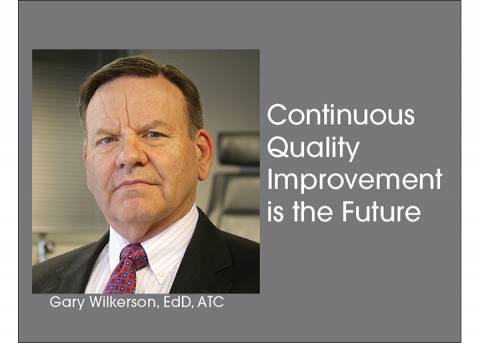
Every day it seems as if there is a new advancement in technology. Whether a new device or app, it seems as if there is a continuous change. For athletic trainers, integrating technology into their everyday clinical work is necessary in order to keep up with the present as well as other health care professions.
In hospitals, for example, they largely work symbiotically with technology. When they take patient notes and collect data, it is mainly done so digitally. Not only does this help allocate information that is easily transferrable to other health care providers and patients, it also follows the institutions to keep up with the digital age, said Gary Wilkerson, EdD, ATC, chair of the NATA Post-Professional Education Committee (PPEC).
Wilkerson presented at the NATA Athletic Training Educators’ Conference in February 2019 about the term “continuous quality improvement.” His lecture, titled “New Knowledge Required for Continuous Quality Improvement in Patient Outcomes,” consisted of three main points: the importance of data collected in clinical settings, evolving changes in the conceptualization of evidence-based practice and relevance of predictive algorithms derived from machine learning.
To simplify, it is imperative for athletic trainers to continue their learning in order to keep up with the demands of the job. For medical practitioners, they are keeping up with these demands by utilizing technology. It is the duty of an athletic trainer to carry on developing skills to use in every setting, Wilkerson said.
From the Beginning
What continuous quality improvement, or its shortened acronym CQI, essentially means is “the systematic process of identifying, describing and analyzing problems and then testing, implementing, learning from and revising solutions. [It is] an ongoing cycle of collecting data and using it to make decisions to gradually improve processes,” according the U.S. Department of Health and Human Services.
The term CQI is a 100-year-old idea that started with physicist Walter Shewhart in Bell Laboratories in order to improve voice clarity in the Bell Telephone handsets, Wilkerson said. However, it should be noted that when CQI first emerged, it was known as statistical process control.
The term TQM, or total quality management, expanded into what is now CQI thanks to W. Edwards Deming, a consultant solicited by the Japanese government to promote economic development. Deming’s concepts were adopted by numerous Japanese companies, Wilkerson said, and created a new way in which they could keep up with the demands of the consumers. TQM is still widely used in the industrial manufacturing sector, Wilkerson said, but CQI wasn’t limited to one industry.
It wasn’t until the 1970s and ’80s when the CQI model became applicable to health care. When it did, however, physician Avedis Donabedian evaluated the quality of medical care and created a model that relied on the process, outcome and structure to work in a cycle for constant improvement.
“Donabedian’s first publications on the topic appeared in the early 1960s, but the idea took time to be accepted and implemented,” Wilkerson said.
Donald W. Berwick, former president of Institute for Healthcare Improvement, also created a model that stated a need for continuous improvement as an ideal in health care.
Now, the concept is still extensively embraced by most successful companies, Wilkerson said, including health care – but is every setting in health care utilizing it? Wilkerson wants to get the word out to ensure CQI is being properly utilized by all.
How Can ATs Get Involved
The No. 1 issue in the athletic training profession, Wilkerson said, is to keep up and get ahead of the game. A method to do so is to follow the CQI model, which ensures what is done evolves as the world evolves.
“Clinicians need to learn how to use their own data effectively,” Wilkerson said. “The point is not to gather data for researchers. There needs to be a partnership between researchers and clinicians to effectively make application of the data to continuously improve the quality of clinical practice outcomes.”
Wilkerson offers some insight into ways ATs can use CQI:
- Clinicians can collect data during interactions with patients.
- Researchers can then put that data together against thousands of cases/studies.
- Researchers will then use the large data and artificial intelligence to extract the important messages.
- Researchers will put the research out into the profession.
- Educators can then use that research to teach students of the new methods, procedures, practice, etc., that come out of the research.
A large part of CQI requires the athletic training profession to get behind technology to ensure the acquisition of clinical data and research continues. Wilkerson said the data collected previously was in smaller amounts and easier to decipher, but now, there is too much data.
“The issue is the ability of clinicians to integrate evidence in the process of making clinical decisions about individual patients,” Wilkerson said.
There are small ways to move toward this new method, such as using mobile devices and apps to track patient outcomes. Every setting can use technology; it is not limited to researchers, clinicians or educators. It will be as a group effort of the profession to keep athletic training as an important part of the ever-changing health care world, Wilkerson said.
“The bottom line is that technology is not going to go away,” Wilkerson said. “The way athletic trainers have always done health care will go away. It is better to dive in, learn and start incorporating technology now because the reality is that things are going to be different moving forward.”
View Wilkerson’s presentation in full.





